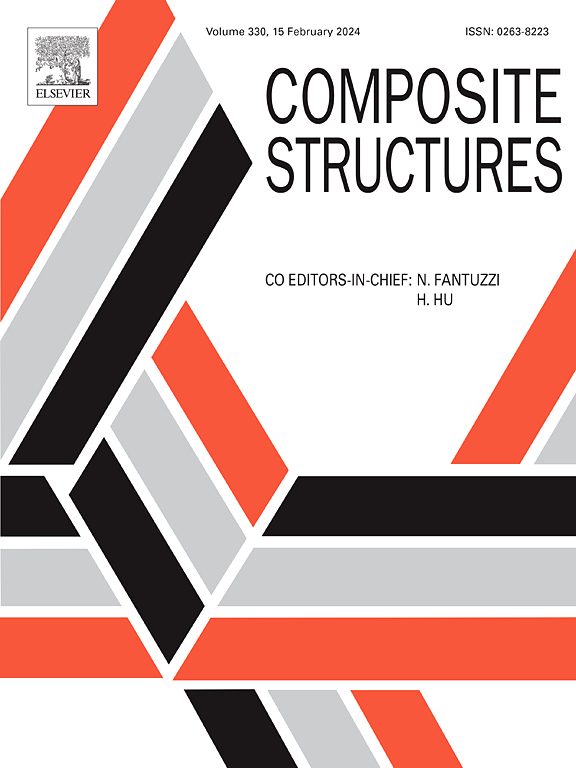Impact of delamination on mechanical performance of glass fiber-reinforced composites by experiments and data-driven model
IF 6.3
2区 材料科学
Q1 MATERIALS SCIENCE, COMPOSITES
引用次数: 0
Abstract
Delamination is usually induced by the manufacturing process and extreme external loads, which significantly threaten the load-bearing capacity of the structures. To reduce the influence of delamination, it is desired to investigate the influencing mechanism of delamination on the mechanical performance of the composite laminates. To this end, 14 types of glass fiber-reinforced polymers (GFRP) unidirectional composite plates with or without circular delamination are fabricated, in which the delaminations are designed in different diameters and locations along the thickness. Subsequently, the static three-point bending tests are performed, in which the test techniques including high-speed camera, digital image correlation (DIC), scanning electron microscope (SEM), and metallographic microscope are employed to measure the damage behaviors. When delamination is close to the upper surface, the experiments show that the layers between the delamination and the upper surface will occur local buckling with the increase of the delamination scale. Local buckling will accelerate delamination growth, whereas such an issue is scarcely reported in the published literature. In addition, the fiber bridging phenomenon can also be observed, which should be considered in the numerical analysis. Compared to the intact specimen, the bending strengths of the specimens with delamination at the location close to the upper surface are reduced by between 12.22% and 30.46%, while those of the specimens with delamination at the location close to the bottom surface are reduced by between 4.56% and 17.08%. To explore more influences of delamination on bending behaviors, an artificial neural network model (ANNM) has been constructed, which can quickly and accurately predict the bending strength of such structures. Such a method will be employed to investigate the bending strength degradation with different delamination sizes.
分层通常由制造过程和极端外部载荷引起,严重威胁结构的承载能力。为了减少分层的影响,我们希望研究分层对复合材料层压板机械性能的影响机理。为此,我们制作了 14 种带或不带环形分层的玻璃纤维增强聚合物(GFRP)单向复合材料板,其中的分层被设计成不同的直径和沿厚度方向的位置。然后进行静态三点弯曲试验,利用高速相机、数字图像相关(DIC)、扫描电子显微镜(SEM)和金相显微镜等试验技术测量损伤行为。实验表明,当分层靠近上表面时,分层与上表面之间的层会随着分层尺度的增大而发生局部屈曲。局部屈曲会加速分层的增长,而这种问题在已发表的文献中鲜有报道。此外,还可以观察到纤维架桥现象,这在数值分析中应加以考虑。与完整试样相比,在靠近上表面位置出现分层的试样的抗弯强度降低了 12.22% 至 30.46%,而在靠近下表面位置出现分层的试样的抗弯强度降低了 4.56% 至 17.08%。为了探索分层对弯曲行为的更多影响,我们构建了一个人工神经网络模型(ANNM),该模型可以快速准确地预测此类结构的弯曲强度。这种方法将用于研究不同分层尺寸下的弯曲强度退化。
本文章由计算机程序翻译,如有差异,请以英文原文为准。
求助全文
约1分钟内获得全文
求助全文
来源期刊

Composite Structures
工程技术-材料科学:复合
CiteScore
12.00
自引率
12.70%
发文量
1246
审稿时长
78 days
期刊介绍:
The past few decades have seen outstanding advances in the use of composite materials in structural applications. There can be little doubt that, within engineering circles, composites have revolutionised traditional design concepts and made possible an unparalleled range of new and exciting possibilities as viable materials for construction. Composite Structures, an International Journal, disseminates knowledge between users, manufacturers, designers and researchers involved in structures or structural components manufactured using composite materials.
The journal publishes papers which contribute to knowledge in the use of composite materials in engineering structures. Papers deal with design, research and development studies, experimental investigations, theoretical analysis and fabrication techniques relevant to the application of composites in load-bearing components for assemblies, ranging from individual components such as plates and shells to complete composite structures.
 求助内容:
求助内容: 应助结果提醒方式:
应助结果提醒方式:


